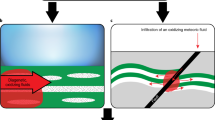Abstract
Precambrian banded iron formations (BIFs) consist of alternating layers of silica and iron minerals such as haematite, magnetite and siderite1,2, but there is controversy as to the origin of the iron. According to one point of view, iron was precipitated from sea water containing Fe(II) ions in solution3,4. Because the photodissociation of water vapour in the Precambrian atmosphere would have been too slow to generate enough of the most probable oxidizing agent, oxygen5, this process would have had to wait for the evolution of organisms producing oxygen. Cairns-Smith6 and Braterman et al.7 alternatively suggested abiotic photodissociation of FeOH+. Through the use of a Precambrian ocean model, I demonstrate here that such a process can quantitatively account for the formation of known BIFs.
Similar content being viewed by others
References
Gole, M. J. & Klein, C. J. Geol. 89, 169–183 (1981).
James, H. L. U.S. geol. Surv. Prof. Pap. 440 -W (1966).
Holland, H. D. Econ. Geol. 68, 1169–1172 (1973).
Drever, J. I. Geol. Soc. Am. Bull. 85, 1099–1106 (1974).
Walker, J. C. G. Pure appl. Geophys. 117, 498–512 (1978).
Cairns-Smith, A. G. Nature 276, 807–808 (1978).
Braterman, P. S., Cairns-Smith, A. G. & Sloper, R. W. Nature 303, 163–164 (1983).
Langmuir, D. U.S. Geol. Surv. Prof. Pap. 650 -B, 180–184 (1969).
Ehrenfreund, M. & Leibenguth, J.-L. Bull. Soc. chim. Fr. 2494–2505 (1970).
Braterman, P. S., Cairns-Smith, A. G., Sloper, R. W., Truscott, T. G. & Craw, M. Dalton Trans., 1441–1445 (1984).
Walker, J. C. G. & Brimblecombe, P. Precambr. Res. 28, 205–222 (1985).
Oeschger, H., Siegenthaler, U., Schotterer, U. & Gugelmann, A. Tellus 27, 168–192 (1975).
Holland, H. D. The Chemical Evolution of the Atmosphere and Oceans, 396 (Princeton University Press, 1984).
Trendall, A. F. J. geol. Soc. Aust. 19, 287–311 (1972).
Garrels, R. M. & Mackenzie, F. T. Evolution of Sedimentary Rocks, 112 (Norton, New York, 1971).
Veizer, J., Compston, W., Hoefs, J. & Nielsen, H. Naturwissenschaften 69, 173–180 (1984).
Wolery, T. J. & Sleep, N. H. J. Geol. 84, 249–275 (1976).
Davison, W. Geochim. cosmochim. Acta 43, 1693–1696 (1979).
Dyrssen, D. & Wedborg, M. in The Sea Vol. 5 (ed. Goldberg, E. D.) 181–195 (Wiley, New York, 1974).
Millero, F. J. Geochim. cosmochim. Acta 43, 1651–1661 (1979).
Gieskes, J. M. in The Sea Vol. 5 (ed. Goldberg, E. D.) 123–151 (Wiley, New York, 1974).
Author information
Authors and Affiliations
Rights and permissions
About this article
Cite this article
François, L. Extensive deposition of banded iron formations was possible without photosynthesis. Nature 320, 352–354 (1986). https://doi.org/10.1038/320352a0
Received:
Accepted:
Issue Date:
DOI: https://doi.org/10.1038/320352a0
- Springer Nature Limited
This article is cited by
-
Reduction of N2 by Fe2+ via Homogeneous and Heterogeneous Reactions Part 2: The Role of Metal Binding in Activating N2 for Reduction; a Requirement for Both Pre-biotic and Biological Mechanisms
Origins of Life and Evolution of Biospheres (2008)
-
Age of the oldest rocks with biogenic components
Journal of Biological Physics (1995)
-
Ferrous iron oxidation by anoxygenic phototrophic bacteria
Nature (1993)





